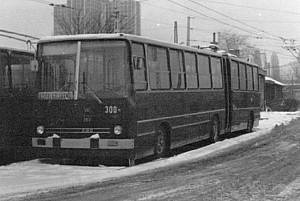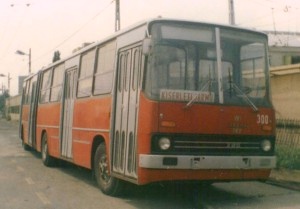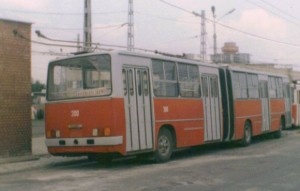|
|
IK-200 series prototype trolleybuses |
|
|
|
|
|
|
|
|
|
|
|
The descriptions of the first BKV-Ikarus trolleybuses:
the solo car 600 (IK-260.T1)
and the articulated version 100
(IK-280.T1) can be found following the links. These were made in
1975.
In 1978 the Ikarus, in cooperation with the swiss factories BBC/Sécheron (Brown-Boweri & Cie AG (Baden) / Sécheron (Geneva)) produced two experimental trolleybuses. The body was made by Ikarus, the electric equippment by the BBC.The first Ikarus - BBC prototype trolleybus (IK-280.T3)
The two BBC prototypes were constructed in the era of the development of the chopper control, in its time it had one of the most advanced equippment in the world. The trolleybus had a single motor with a relatively simple electronics; the frequency of the chopper was 440 Hz. Instead of a rheostatic brake it used an eddy-current brake, so called TELMA brake. This made possible a quite strong, 1.5 m/s2 deceleration, which could be regulated in four cascades using the brake pedal, before the pneumatic brake started. The TELMA brake was excited from a generator fitted on the motor-axle. By measurements, with the chopper control (without the possibility of recuperation) the energy savings reached 20 %. The trolleybus was equipped with an automatic trolley retrievers (type Delachaux), with BBC trolleys. This trolleybus had also a Volkswagen type petrol-aggregate for runs without wire. Its auxiliary devices (compressor, generator) was powered with a 3 kW motor through v-belts.
However, the use of the TELMA brake increased the size and weight of the electric equippment, and everywhere later there came out problems with it - worldwide: from Norway to New-Zealand. The electrical configuration of the first prototype trolleybus of Ganz were actually very similar to the Ikarus-BBC trolleybuses.
Some technical data:
Originally the body was made by Ikarus in 1977, but the electric equippment was fitted in Switzerland, in Geneva. So the first trial runs were also done there, and only later came to Budapest. Then the trolleybus was on a demonstration tour in North-America. It made testruns in Mexico City in 1981, then in San Francisco and Seattle in 1982. After the tests the vehicle came back to the estate of the Ikarus factory, where its electrical equippment was removed. The fate of the empty body is unknown, some people speculate about a possible further use of it.
length: 16500 mm standing places: 110 width: 2500 mm seats: 35 height: 3500 mm motortype: 4 ELO 2052 k weight: 14400 kg max. output: 168 kW
The second BBC prototype was constructed also in 1978. The electric equippment of this trolleybus was similar to the first prototype, it was fitted with chopper control and TELMA brake. Also a VW-AEG petrol-aggregate was built in the rear of the vehicle.The second Ikarus - BBC prototype trolleybus (IK-280.T3/1)
This prototype was on testruns in western Europe: first in Linz (Austria) in 1980, then in Grenoble (France). But after these demonstrations the trolleybus was not in service until 1986, partly in this time it was used at Ganz for experimenting the GVMs' electronics. In 1986 its empty body was carried to Szeged (Hungary), where in the local depot it was re-equipped with the devices of the standard GVM series. Officially it was taken to Szeged's fleet in 31st October 1987, with the fleet number T6-282. The trolleybus was not very often in service until the middle of the '90s. It was scrapped in 31st December 1999, though the trolleybus actually dismantled after 2002.
In 1978, the Ikarus and the German company Kiepe constructed another new prototype. Again, the Ikarus made the body, which was equipped in Düsseldorf the electric devices by Kiepe (in 1979?). This trolleybus had conventional resistror-based electrics regulated by an electropneumatic contactors.The Ikarus - Kiepe prototype trolleybus (IK-280.T4)
Some technical data:
As it happened with several prototype trolleybuses, Szeged has also fished out this trolleybus from the withdrawn "special fleet" in Budapest. This car was one of the first articulated vehicle in the town's newly built system, it started its service in 1982. Officially it was taken in the fleet in 19. July 1984, with the number T4-281. The trolleybus was scrapped in 31st December, 1992.
length: 16500 mm standing places: 110 width: 2500 mm seats: 35 height: 3500 mm motortype: BGK 75-37,5 ff weight: 12200 kg max. output: 150 kW
The Hitachi trolleybus was possibly the first try from 1977 (by its chassis-number) of the Ikarus to install chopper control in the IK-280 type. But it seems, that the vehicle was finished only in 1980 for trial runs. The trolleybus was fitted with Japanese Hitachi electronics, though the equippment was built in in the Ganz factory (?). This prototype also had a VW aggregate, so it was able to move without wires.The Ikarus-Hitachi prototype (IK-280.T7)
This trolleybus was carried to Szeged in 1985, it was taken into the
fleet with the number T7-281 in 17. December 1985; though its first
run there with passengers was only in the middle of 1986. Officially it
was scrapped in 31st December 1998, but it was set aside earlier in 1994.
The story of this experimental car begins in 1981. The Ikarus, the BKV (Budapest Transportation Company) and the VKI (Research Institute of Electric Industry) together built this trolleybus with a special propulsion, which obtained the fleet number 300 by the BKV. Originally this trolleybus had a two motor construction with hydraulic transmission. One of the motor was removed during the trial runs.The Ikarus - BKV - VKI experimental trolleybus (IK-280.T8)
The hydraulic transmission was earlier known only on diesel-locomotives, although in these years the MAN-BBC-Voith made also together a hydraulic prototype which ran in Lausanne (Switzerland). With this construction, the engeneers wanted to avoid the chopper electronics, which were causing many faults at the time. Also this gave a possibility to avoid the chopper-regulated rheostatic brakes (which were on many electronic types avoided not to overload the delicate semi-conductors). The conception was to use a transmission similar on autobuses, which meant also to use some of the serial equippment of the bus industry. Peaople hoped to reduce with this the costs of the trolleybuses (the TELMA brakes were used also for similar reasons).
Finally such hydraulic trolleybuses had nowhere a successor. The fate
of the 300 is unknown, possibly it was taken to the VKI's place.
 |
|
|
|
|
 László Takács
|
 László Takács
|
|
|
|
The Finnish company Strömberg near a Winterthur (Switzerland) and a Helsinki (Finnland) prototype, also produced a three-phase asynchronous motor trolleybus together with Ikarus. The vehicle was ready in 1983/84, using an IK-284 body. This 18 m long car had significantly lower floor level than the IK-280 articulated types, since the motor was mounted in the rear. This explains also the three doors on the side, which was unusual in Budapest. This was the only articulated trolleybus with a C-axle drive in Budapest.The IK-284 - Strömberg trolleybus (IK-284.T1)
The construction was not also very succesful, its greatest disadvantage was its electronics. On many trolleybuses, the power of the motor does not pause neither by acceleration, nor by breaking, even when the driver is not pushing any pedal. The reason is, that it is better for the mechanical parts, when they are not in a force-free state: the swaying and the shaking can be avoided this way. Also the three-phase electronics is simpler, if the motor is not turned off during it is running.
However the remaining power means energy consumption or recuperation, when the trolleybus is moving, and the level of the flowing current was so high, that the trolleybus always operated the points on its route (in Budapest, for changing the direction of a point one needs to accelerate the trolleybus on a sepcial section of the pole). Such problem was not known in the western systems, where the points are operated by radio remote control.
The trolleybus was fitted with a 175 kW (?) three-phase motor. Also it had a VW petrol-aggregate. After the trial runs, until the '90s it stood out of service in the BKV's depot. After 1990, the technicians of the BKV tried to resurrect the trolleybus with a change in its electronics. The vehicle was repainted, and obtained the fleet number 198. But soon the plan was dropped, when the BKV recieved the original Finnish drawings, that nobody was able to understand. Although the trolleybus had some trial runs with passengers again on the route 80, finally it was dismantled.
Literature:
Danka Miklós - Glofák Péter - Kiss Miklós: Gumikerekes
járművek villamos hajtása (MK. 1980.)
The
pages of Bálint Hajtó
2005.XI.